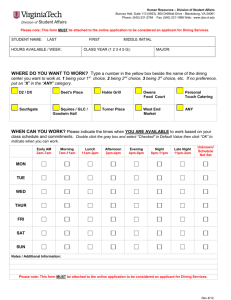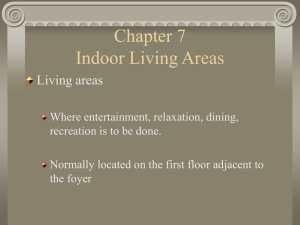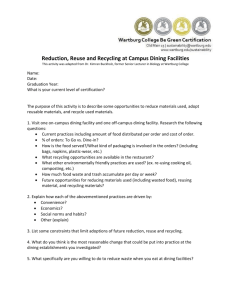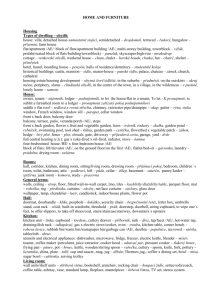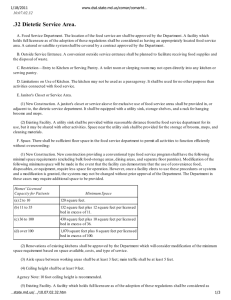MARYLAND
advertisement
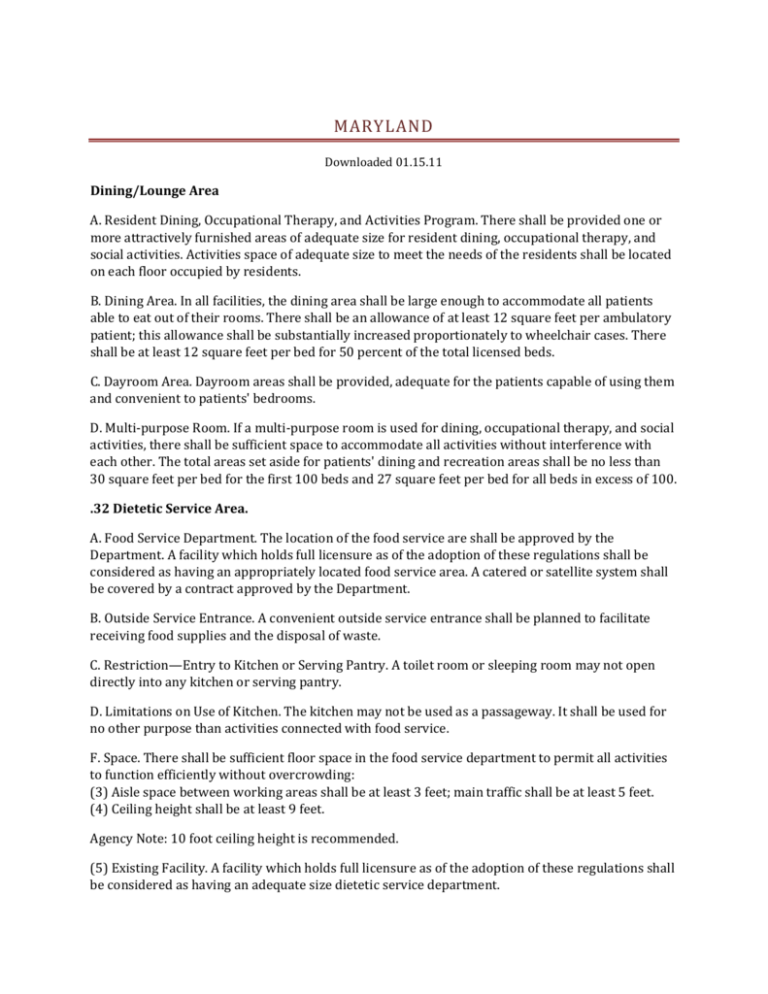
MARYLAND Downloaded 01.15.11 Dining/Lounge Area A. Resident Dining, Occupational Therapy, and Activities Program. There shall be provided one or more attractively furnished areas of adequate size for resident dining, occupational therapy, and social activities. Activities space of adequate size to meet the needs of the residents shall be located on each floor occupied by residents. B. Dining Area. In all facilities, the dining area shall be large enough to accommodate all patients able to eat out of their rooms. There shall be an allowance of at least 12 square feet per ambulatory patient; this allowance shall be substantially increased proportionately to wheelchair cases. There shall be at least 12 square feet per bed for 50 percent of the total licensed beds. C. Dayroom Area. Dayroom areas shall be provided, adequate for the patients capable of using them and convenient to patients' bedrooms. D. Multi‐purpose Room. If a multi‐purpose room is used for dining, occupational therapy, and social activities, there shall be sufficient space to accommodate all activities without interference with each other. The total areas set aside for patients' dining and recreation areas shall be no less than 30 square feet per bed for the first 100 beds and 27 square feet per bed for all beds in excess of 100. .32 Dietetic Service Area. A. Food Service Department. The location of the food service are shall be approved by the Department. A facility which holds full licensure as of the adoption of these regulations shall be considered as having an appropriately located food service area. A catered or satellite system shall be covered by a contract approved by the Department. B. Outside Service Entrance. A convenient outside service entrance shall be planned to facilitate receiving food supplies and the disposal of waste. C. Restriction—Entry to Kitchen or Serving Pantry. A toilet room or sleeping room may not open directly into any kitchen or serving pantry. D. Limitations on Use of Kitchen. The kitchen may not be used as a passageway. It shall be used for no other purpose than activities connected with food service. F. Space. There shall be sufficient floor space in the food service department to permit all activities to function efficiently without overcrowding: (3) Aisle space between working areas shall be at least 3 feet; main traffic shall be at least 5 feet. (4) Ceiling height shall be at least 9 feet. Agency Note: 10 foot ceiling height is recommended. (5) Existing Facility. A facility which holds full licensure as of the adoption of these regulations shall be considered as having an adequate size dietetic service department. (6) If the licensed capacity of a facility is increased, or meals are provided to anyone outside of the facility from the food service area of the facility, the facility shall provide additional food service area in accordance with §F(1), (3), and (4) of this regulation. The additional food service area required when meals are provided to anyone outside of the facility is to be calculated by using the total number of individuals to whom meals are provided. (7) The kitchen space requirement in §F(6) of this regulation does not apply to occasional special functions such as picnics or dinners for residents, volunteers, families, or community groups provided the facility certifies to the Department that the provision of meals for the particular special function will not adversely affect or detract from the timely provision of meals to the residents of the facility. G. Floor Pantries—New Construction. (1) In a decentralized food service, the area or areas for floor pantries shall be approved by the Department. (2) This area shall be of sufficient size to accommodate the equipment required for food preparation and service. Agency Note: The following equipment is recommended: (a) Equipment to maintain food at correct temperature; (b) Toaster; (c) Hot plate; (d) Refrigerator; (e) Ice‐making machine or ice‐storage container; (f) Work space for tray preparation; (g) Equipment for delivery of completed trays; (h) Three‐compartment sink or dishwasher; (i) Cabinet for dry storage and supplies; (j) Storage for trays, tableware, flatware, and utensils; (k) Handwashing sink with soap and towel dispenser or approved drying device. (3) At least one nourishment pantry convenient to the nursing station shall be provided on each floor in facilities using a centralized food service system. Minimum equipment shall include the following: (a) Refrigerators; (b) Cabinets for dry storage and supplies; (c) Work space; (d) Sink for purposes other than handwashing; (e) Handwashing sink with soap and towel dispenser or approved drying device. H. Equipment for Food Preparation and Distribution. The following requirements shall be met: (1) Adequate equipment for preparation, serving, and distribution of food shall be provided; (2) A dumbwaiter, elevator, or ramp shall be provided in a facility of more than one story where more than eight patients, above or below the kitchen level, receive bedside tray service; (3) Equipment to protect food from dust or contamination and to maintain food at proper temperature shall be provided for transportation of food to the patients. I. Dry Food Storage. The following requirements shall be met: (1) Adequate space shall be provided for the storage of food supplies; Agency Note: The amount of storage space needed is dependent upon frequency of deliveries. It is recommended that 2 square feet per patient be provided and that the area be located within easy access to the receiving area and the kitchen. (2) The storeroom shall be cool and well ventilated; (3) All food supplies shall be stored off the floor and away from the wall to allow for cleaning. Agency Note: Care should be exercised in the rotation of stored food so that old stock is used first. J. Refrigerated Storage. Adequate refrigerated storage, refrigerators and frozen food storage cabinets, shall be provided which are regulated to maintain temperatures prescribed in COMAR 10.15.03 Food Service Facilities. (5) Activity Areas. All facilities shall provide on every floor and for every unit a comfortable, pleasant, convenient, well‐lighted and ventilated sitting room, day room, or solarium with a direct outside exposure that is separate from patient or resident bedrooms. (Exceptions may be allowed upon written approval of the Department.) This room shall be so constructed, arranged and maintained that patients or residents have a place to read, play cards, visit or watch television. This room shall be large enough to meet patient needs and shall be suitably located. (8) Kitchen. (a) The main kitchen shall be located in a suitable area. There shall be adequate work space for the sanitary preparation and serving of meals for patients, residents and personnel, in accordance with the size of the facility. All main kitchens shall be provided with a mechanical ventilator. (b) Kitchens and other areas when located below grade level and used for the preparation and serving of food shall either have direct access to the outside by means of suitable windows or ventilation shall be provided to permit an air supply and exhaust of at least ten air changes an hour. Ventilating units shall be maintained in a sanitary manner and kept in good repair. (c) Adequate sanitary storage space and cabinets shall be provided for the proper storage of all foods, dishes, silverware and cooking equipment and maintained in a sanitary manner and kept in good repair. (d) Auxiliary kitchens shall be provided and adequately equipped when the size of the facility or the physical plant indicates the need, as determined by the Department. (e) A dumb‐waiter when provided for the transportation of food shall be suitably located and used exclusively for the transportation of food. It shall be cleaned daily and kept in good repair. (f) Stoves, sinks, counters, cabinets, shelves, tables, refrigerating equipment and all other equipment necessary for the preparation and serving of food shall be provided in accordance with the size of the facility. This equipment shall be so constructed that it can be easily cleaned, maintained in a sanitary manner and kept in good repair. (g) A handwashing sink with hot and cold running water, a soap dispenser and disposable towels in a towel dispenser shall be located in the kitchen area. (h) All facilities shall provide by January 1, 1972, an automatic dishwasher capable of handling the needs of the facility. For dishwashing machines, the temperature of the water shall be between 140 and 160º F with a final rinse at a temperature of 170 º F or higher. (i) Appropriate areas shall be provided for cart washing and can washing. (9) Dining Rooms. All facilities shall provide at least one dining area for patients or residents, including wheelchair cases, who can and wish to eat at a table. (Exceptions may be made upon written approval of the Department.) Dining rooms shall be: (a) Suitably located in an attractive, well‐lighted, ventilated and heated area that is separate from sleeping quarters and areas of congestion. (b) Equipped with tables of sturdy construction with hard surfaced, washable tops. (c) Equipped with comfortable chairs of sturdy construction and of a sanitary type. (d) Provided with floors that have a waterproof and greaseproof covering. Only non‐skid wax shall be used in the dining room area. New Construction of Dining/Lounge Area (1) New Construction. New construction providing a conventional type food service program shall have the following minimal space requirements (excluding bulk food‐storage areas, dining areas, and separate floor pantries). Modification of the following minimum space will be made in the event that the facility can demonstrate that the use of convenience food, disposables, or equipment, require less space for operation. However, once a facility elects to use these procedures or systems and a modification is granted, the systems may not be changed without prior approval of the Department. The Department in these cases may required additional space be provided. Homes' Licensed Capacity for Patients Minimum Space 2 to 10 120 square feet 11 to 35 132 square feet plus 12 feet per licensed bed in excess of 11 36 to 100 430 sq feet plus 10 sq ft per licensed bed in excess of 36 Over 100 1,070 sq ft plus 8 sq ft per licensed bed in excess of 100 (2) Renovations of existing kitchens shall be approved by the Department which will consider modification of the minimum space requirement based on space available, costs, and type of service. Summary: Furnishings, Size; Square Feet per Patient; Accommodation; Day Room; Kitchen Location; Food Preparation Equipment; Storage
